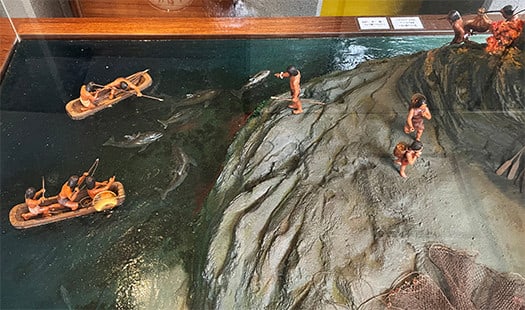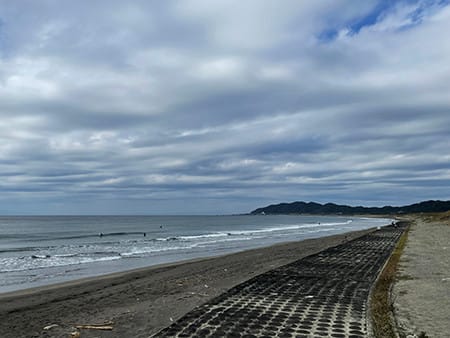



5回にわたって「徳島三木家住宅」の発掘型住宅取材を行ってきた。前後するのだけれどわたしは昨年に房総南端、館山を訪れる機会があって地域の博物館などでその歴史を探っていた。房総地域というのは古代から「麻」の栽培が盛んだったとされている。WEB検索で「総(ふさ)の国」と入力すると「四国の阿波の忌部氏は黒潮に乗って房総半島に進出し、この地の良質な麻を栽培したことから「総(ふさ=麻)の国」と呼ばれるようになり、後に2つに分けられ、上総(かみつふさが短縮)、下総(しもふさ)の国名となりました。」という記述に突き当たる。
中臣氏(藤原氏)との朝廷内部での勢力争いの敗勢から地方進出に活路を見出した「忌部氏」が房総の国の開発利権を賜ったという経緯について連載記事でもまとめた。そして上総・下総と並んで「安房」と同音の国名が地域名として命名され残っている。部民一族の神聖な生産様式伝統が、朝廷儀礼としての麁服(あらたえ)の調進ということからあきらかな歴史痕跡として見えてくるのだ。上の写真は館山市博物館展示での最初期開拓民の生活様式をジオラマ化したもの。忌部氏の部民の房総への進出は、初期から波動のように移住開拓がされていったことだろう。最初の移住者たちはこのような黒潮魚類捕食と洞窟居住からスタートを切った。


本国阿波に残留した一族は、安房に進出した同胞について祈り続けたに違いない。部民のなかから若者世代を選抜して長久を願って送り出した。日本史の中でのこういう地域進出は直近ではわたしたち北海道民が経験してきたこと。わたしは地域進出後の第3世代に属するのだけれど、やはりはるかな故地への思いは個人の範囲を超える重さがある。現代では交通も発達して相互移動することは容易だが、この当時はそれこそ「水杯」を交わしての決死の別れを経て移住してきたのだろう。若い移住世代たちは新天地での浪漫に胸を焦がしたか、ちょうど現生人類の拡散同様のことがこのように繰り返されて現代があるのだろう。



血縁的にはあまり縁がなかった三木家住宅探訪記ですが、しかし個人的には「運命的に」(笑)導かれているように感じられた。関東という地域も弥生の稲作農業が拡散していく過程でこのような移住民たちが進出して地域開発がされていったのだろう。そして日本民族の場合、すぐに社会の中心に神社のような「公共空間」が開発されていく。上の写真の「安房神社」はこうした部民一族としてのはるかな記憶の象徴・固定化の役割も担ってきたと思う。洞窟痕跡が神域に散在しているのは、一族としての進出最初期の記憶の継承を考えたものか。洞窟も住宅として機能したに違いない。先人の生き様の鮮明な痕跡。
住宅というものの基本的役割、人間文化のコアを誇りを持って保守すること。その実質をさまざまな側面から教えてくれた徳島・三木家住宅だったと思っている。
English version⬇
From Awa to Boso Awa, Tokushima, Miki Family Residence Spin-out Edition
The Awa Imobe clan developed the region of Boso, Chiba as a group. At first, they lived in caves and secured food through fishing, and gradually developed the region by promoting hemp production. The Awa Imobe clan lived in caves to secure food by fishing, and gradually developed the area through hemp production.
I had the opportunity to visit Tateyama, located at the southern tip of Boso, last year, and I have been exploring the history of the area at a local museum and other places. It is said that hemp has been cultivated extensively in the Boso area since ancient times. When I typed in the word "Fusa-no-kuni" in a search engine, I came across the following description: "The Imobe clan of Awa in Shikoku rode the Kuroshio Current to the Boso Peninsula and cultivated the high-quality hemp of this region, which led to the name of the region as "Fusa-no-kuni" (the land of "So"). This is the description of the "Kami-sousa" and "Shimotsousa.
In the series of articles, we learn that the Imobe clan, which had found a way to expand into the provinces after losing a power struggle with the Nakatomi clan (Fujiwara clan), was granted the development rights of the country of Boso. The name of the country, which has the same sound as "Awa" as well as "Kamisusa" and "Shimosusa," remains as the name of the region. The tradition of the sacred production style of the tribal clans of the area, which involved the preparation of clothing as a ritual for the imperial court, is clearly visible as a trace of history. The photo above is a diorama of the lifestyle of the earliest settlers in the Tateyama City Museum exhibit. In the early days of the Imobe clan's expansion into Boso, the settling of the area must have occurred in waves. The first settlers started from this kind of predatory lifestyle and cave dwelling.
The family members who remained in their homeland of Awa must have continued to pray. The young generation was selected from among the tribe members and sent out with the hope of longevity. This kind of regional expansion in Japanese history has been experienced most recently by the people of Hokkaido. Although I am a member of the third generation after the regional expansion, my feelings for the faraway land of my ancestors are beyond the scope of an individual. Today, transportation has developed to the point where it is easy to move from one place to another, but in those days, people probably migrated after exchanging "water cups" and parting with each other in mortal combat. The younger generation of immigrants may have been excited by the prospect of a new land, or they may have repeated the same process of spreading the present-day human race.
Although I was not related to the Miki family in blood, however, I personally felt as if I was "destined" (laugh) to be led to the Miki family's house. It is likely that the Kanto region was also developed by these immigrants who moved into the area as Yayoi rice agriculture spread throughout society. In the case of the Japanese people, "public spaces" such as shrines were soon developed at the center of society. In particular, I believe that the Awa Shrine has played the role of symbolizing and fixing the memories of these tribal peoples. The fact that the cave traces are scattered throughout the shrine is a way of passing on the memories of the first phase of the clan's expansion. The caves must have also functioned as residences. Traces of our ancestors' way of life.
I believe that the Miki family residence in Tokushima taught us from various aspects the basic role of a house and the need to maintain the core of human culture with pride.



















